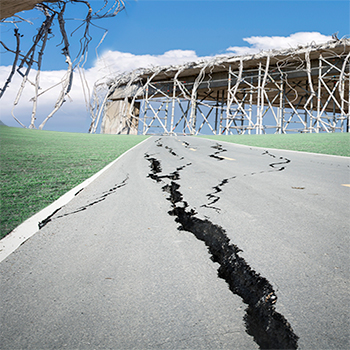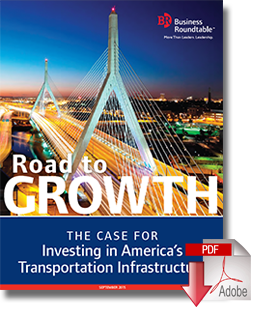While details of President-elect Donald J. Trump’s so-called trillion-dollar infrastructure stimulus are still unclear, the need for such big spending on the nation’s crumbling bridges and highways is not.
“It is crumbling,” Brad Jacobs, chairman and CEO of XPO Logistics, parent company of the nation’s second-largest less-than-truckload carrier, said.
“It’s everything, from roads, bridges, and tunnels.”
If enacted properly - and that’s a big if - a major infrastructure rebuilding program would “help make us more efficient,” Jacobs said.
XPO Logistics operates more than 15,000 power units with in excess of 300 service centers throughout North America, making it one of the largest trucking operators in the nation utilizing an aging infrastructure.
“Congestion around metropolitan areas has progressively gotten worse over the years,” Wayne Spain, president and COO of Averitt Express, the nation’s 12th-largest LTL carrier, noted.
“Unfortunately, we’ve been slow to respond to expanding roadways and public transportation services,” Spain added.
“Hopefully, future infrastructure projects will help alleviate the challenges that commuters and truck drivers are experiencing on our nation’s increasingly busy interstates and highways.”
Incoming Transportation Secretary Elaine Chao has said it’s time to “unleash the potential” of private capital to modernize that infrastructure.
She said at her confirmation hearing before the Senate Commerce, Science and Transportation Committee that economic gains are being jeopardized by infrastructure “in need of repair, the specter of rising highway fatalities, growing congestion, and by a failure to keep pace with emerging technologies.”
Chao said it’s time to take advantage of what she called new “innovative financing tools” that can “take full advantage of the estimated trillions in capital that equity firms, pension funds, and endowments can invest.” This, she added, would be a “bold, new vision” for transport.
While details are unclear, administration officials are floating some $137 billion in tax credits to infrastructure investors. It’s estimated these tax credits would generate an estimated $1 trillion in private sector investment over 10 years.
But whether that $1 trillion would go to the most-needed infrastructure jobs - or merely those that produce the biggest revenue streams to investors - is an open question.
Read: Trump's Infrastructure Plan Wouldn't Actually Fix America's Infrastructure Problems
Meanwhile, the outgoing Transportation Secretary Anthony Foxx is warning that private money can cover part of the costs of solving America's transportation problems - maybe 10 to 20 percent.
“We still going to need a fair amount of public funding,” Foxx told the Associated Press. “I don't see public-private partnership as a 100 percent strategy to solve our transportation problems.”
State transportation officials repeatedly have called for financial assistance for a backlog of repairs and maintenance - not necessarily new, fancy projects.
Whatever projects these turn out to be, don’t expect them too soon. While Trump repeatedly touted infrastructure during his campaign, Trump and his team have been conspicuously short of details since his election. But don’t expect much in his much-touted first 100 days, which are consumed with gutting the Affordable Care Act and other ideological goals.
“We’re going to start to work on it, but first of all, you’ve got to figure out the pay-fors, which will come, I believe, in the first 100 days,” Rep. Bill Shuster, chairman of the House Transportation and Infrastructure Committee, said.
“Then in the next second 100 days is when we’ll put together a big infrastructure package.”
That would place the timing of it sometime this summer. House Speaker Paul Ryan, R-Wis., also said he would address infrastructure “between now and our spring budget.”
He said Republicans want “transportation dollars (to) stretch as far as possible.”
The focus, Ryan said, would be on “leveraging private sector dollars so that it's not just the public sector taxpayer, the taxpayer that's on the hook.”
Trump recently told The New York Times that infrastructure would not be a “core” part of his agenda.
White House chief of staff Reince Priebus has said that ObamaCare repeal and tax bills will take precedent over infrastructure.
While Republicans seem unlikely to generate revenue through an increase in the motor fuels tax – 24.4 cents on diesel, 18.4 cents on gasoline, unchanged since 1993 – states are moving ahead with their own sizeable fuel tax increases. Even states with Republican governors are doing it.
Michigan’s Rick Snyder recently signed a 38.4 percent increase in that state’s fuel tax - 11.3 cents a gallon more to 30.3 cents a gallon. New Jersey’s Chris Christie late last year OK’d a whopping 23 cent increase to make that state fuel tax 37.5 cents a gallon.
Whatever the increases, truckers seem willing to accept it as a tradeoff for more efficient operations. And besides, they say privately, it’s relatively easy to pass on those costs to shippers through higher fuel surcharges.
“I’m 100 percent for Michigan increasing the taxes,” Evan Souten, president of Modular Transportation, an 80-truck operation in Grand Rapids, recently told Transport Topics, the newspaper of the American Trucking Associations.
“It needed to happen,” he added. “We have to spend money money on the roads and bridges to keep them in good shape…But I would rather they did it 100 percent on fuel, not on the license plates (fees), because fuel is a little bit easier to pass on to your customers.”
Other trucking executives agreed the time was due - actually overdue - for an ambitious national infrastructure spending program.
“This should have been done 25 years ago,” XPO’s Jacobs said of the nation’s deferred infrastructure needs. “But better late than never.”
News Update: The Senate Democrats $1 Trillion Infrastructure Plan
The Economic Power of Rebuilding America’s Transportation Infrastructure
After Decades of Neglect, Investing in System Will Boost U.S. Economy and Create Jobs
Washington - A new analysis by Business Roundtable outlines the economic cost of neglecting the nation’s transportation infrastructure and the positive effects of rebuilding it for the 21st Century.
Road to Growth: The Case for Investing in America’s Transportation Infrastructure contrasts America’s current investment with 20th Century levels – a period when the country was committed to building the roads, bridges and waterways that moved the economy forward.
“The U.S. economy absolutely relies on a strong national transportation infrastructure,” said Doug Oberhelman, Chairman and CEO of Caterpillar Inc. and Chair of the Business Roundtable infrastructure initiative. “But much of our infrastructure is aging, outdated and unreliable. This report gives all the reasons necessary to take action, as soon as possible, to rebuild our infrastructure assets so we can both support and grow the U.S. economy.”
Among the key findings included in the report:
- America Is No. 16: The United States’ overall infrastructure quality ranks 16th, behind such countries as Germany, France and Japan.
- Highways and Bridges: Urban highway congestion cost the economy more than $120 billion in 2011, and nearly one in four bridges in the national highway system is structurally deficient or functionally obsolete.
- Waterways and Ports: Lock delays, port congestion and lack of facilities for larger ships added $33 billion to the cost of U.S. products in 2010.
- As much as $3 in economic activity is created by every $1 invested in infrastructure.
- Up to $320 billion in economic output would be generated in 2020 if U.S. infrastructure investment were boosted by 1 percent of GDP per year.
Article topics
Email Sign Up




















